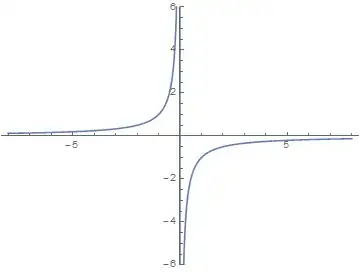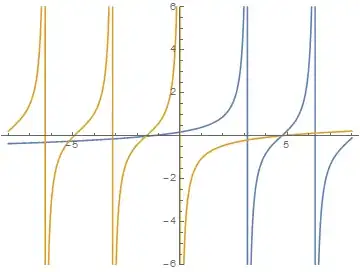Although there is already an answer of mine, I want to add another answer.
This is TL;DR.
Short answer. This is because logarithmic function lacks factorial in its Taylor expansion.
Medium answer. Riemann's functional equation links exponential and trigonometric functions with logarithms and inverse trigonometric. It contains everything what you need to make an exponent from a logarithm.
Long answer.
This is Taylor series for logarithm:
$$\ln(z+1)=z-\frac{z^2}{2}+\frac{z^3}{3}-\frac{z^4}{4}+\frac{z^5}{5}-\frac{z^6}{6}+\frac{z^7}{7}-\frac{z^8}{8}+\frac{z^9}{9}-\frac{z^{10}}{10}+O\left(z^{11}\right)$$
This is Taylor series for exponent:
$$\exp (z)-1=z+\frac{z^2}{2!}+\frac{z^3}{3!}+\frac{z^4}{4!}+\frac{z^5}{5!}+\frac{z^6}{6!}+\frac{z^7}{7!}+\frac{z^8}{8!}+\frac{z^9}{9!}+\frac{z^{10}}{10!}+O\left(z^{11}\right)$$
What should we add to the former to get the later? Well, we have to add the factorial and remove the counter from the denominator.
Consider such algebraic element $\omega_+$ (not a real number) on which a function "standard part" is implemented in such a way, that $\operatorname{st} \omega_+^n=B_n^*$ where $B_n^*$ are Bernoulli numbers (with $B_1^*=1/2$), or more generally, $\operatorname{st}\omega_+^x=-x\zeta(1-x)$.
Now consider the function
$$\frac{z}{2\pi} \log \left(\frac{\omega _+-\frac{z}{2 \pi }}{\omega _++\frac{z}{2 \pi }}\right)$$
Its Taylor series is
$$-\frac{z^2}{2 \left(\pi ^2 \omega _+\right)}-\frac{z^4}{24 \left(\pi ^4 \omega _+^3\right)}-\frac{z^6}{160 \left(\pi ^6 \omega _+^5\right)}-\frac{z^8}{896 \left(\pi ^8 \omega _+^7\right)}-\frac{z^{10}}{4608 \left(\pi ^{10} \omega _+^9\right)}+O\left(z^{11}\right)$$
Following Riemann's functional equation and our definition, we have:
$$\operatorname{st}\omega_+^{-x}=\operatorname{st}\frac{-\omega_+^{x+1} 2^x\pi^{x+1}}{\sin(\pi x/2)\Gamma(x)(x+1)}$$
So we can substitute the negative powers of $\omega_+$ with positive powers without changing the standard part of the whole expression.
The non-zero terms are
$$\frac{2 \left(-\frac{1}{2 \pi }\right)^n \left(-\omega _+\right){}^{1-n}}{n-1}$$
and after substitution we have
$$\frac{\omega _+^n \sec \left(\frac{\pi n}{2}\right)}{\Gamma (n+1)}$$
The resulting series is
$$\frac{1}{2} \omega _+^2 z^2+\frac{1}{24} \omega _+^4 z^4-\frac{1}{720} \omega _+^6 z^6+\frac{\omega _+^8 z^8}{40320}-\frac{\omega _+^{10} z^{10}}{3628800}+O\left(z^{11}\right)$$
oh, wait... is not it similar to
$$\cos \left(\omega _+ z\right)=1-\frac{1}{2} \omega _+^2 z^2+\frac{1}{24} \omega _+^4 z^4-\frac{1}{720} \omega _+^6 z^6+\frac{\omega _+^8 z^8}{40320}-\frac{\omega _+^{10} z^{10}}{3628800}+O\left(z^{11}\right)$$
Well, we got:
$$\operatorname{st}\frac{z}{2 \pi } \log \left(\frac{\omega _+-\frac{z}{2 \pi }}{\omega _++\frac{z}{2 \pi }}\right)=\operatorname{st}(\cos \left(\omega _+ z\right)-1)$$
In a similar way one can establish other impressive relations:
$$\operatorname{st}(\exp \left(\omega _+ z\right)-\omega _+ z-1)=\operatorname{st}\frac{i z}{2 \pi } \log \left(\frac{\omega _+-\frac{i z}{2 \pi }}{\omega _++\frac{i z}{2 \pi }}\right)$$
$$\operatorname{st}\cos \left(\omega _+ z\right)=\operatorname{st}\frac{ z}{2 \pi } \log \left(\frac{\omega _+-\frac{ z}{2 \pi }}{\omega _-+\frac{ z}{2 \pi }}\right)$$
$$\operatorname{st}\cosh \left(\omega _+ z\right)=\operatorname{st}\frac{i z}{2 \pi } \log \left(\frac{\omega _+-\frac{i z}{2 \pi }}{\omega _-+\frac{i z}{2 \pi }}\right)$$
(where $\omega_-=\omega_+-1$).
In other words, Riemann's functional equation is a direct bridge that connects exponential function to logarithm, trigonometric functions to inverse trigonometric, transforming each term of the series separately.

